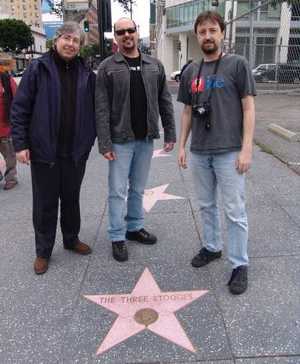 From right to left: Scott, Bruno and myself (the three Haiku stooges?) at the Hollywood Walk of Fame.
From right to left: Scott, Bruno and myself (the three Haiku stooges?) at the Hollywood Walk of Fame.
The Southern California Linux Expo – or the SCaLE show as it is also widely known – was the very first mainstream open source conference that Haiku exhibited at. This was back in February of 2007, when Michael Phipps, Axel Dorfler, Bruno G. Albuquerque and myself gathered in LA to show Haiku to the world for the first time (photos here). Following the once a year tradition that SCaLE has become since then, Bruno G. Albuquerque, Scott McCreary and myself gathered to represent Haiku at the SCaLE 2010 conference, recently held in Los Angeles on the weekend of February 20th and 21st.
On Saturday morning, the three of us gathered on the exhibit floor at around 9:00AM, one hour before the exhibition was scheduled to open to the public. This gave us plenty of time to prepare the booth, especially because we had already setup the projector screen on the backwall the evening before. We placed the HAIKU table runner over the 7 feet long table that we had at the booth, and then laid out – from left to right – Scott's AMD dual core laptop, my small cube-sized Intel dual core desktop hooked to a projector, and an 8-core laptop that belonged to Bruno's girlfriend. As handouts, we had the new Haiku flier as well as 50 alpha 1 CDs that Scott had burned on Lightscribe media.
Wow, it’s been 10 days already since I posted my first blog entry on my work on WebKit and the native web browser. Of course my continous updates to the package I posted in my first article will probably have spoiled most of the surprise, but HaikuLauncher has been reduced again into just a bare browser shell, while a new codebase, WebPositive, has been split off from it. Using WebPositive has become a whole lot more pleasing in the meantime. For those of you who have not followed the comments to the original blog, these are the things implemented since my first post on the project:
It’s hard for me to believe that I’ve been publishing these mostly-weekly lessons for almost a month and a half. It’s been really fun. I hope that those of you reading them have been enjoying reading (and hopefully learning from) them as I have in writing them. This one covers two major topics: memory management and binary math, nothing terribly exciting, but really useful and necessary nonetheless. Learn to Program With Haiku, Lesson 7.
First of all, I want to thank Haiku, Inc. for giving me the opportunity to concentrate fully for a while on the WebKit port and browser! This is an awesome chance that I intend to make full use of.
At the moment, I have mixed feelings. Not about writing blogs. Not about working on WebKit. But about using the new WebKit browser to write the blog entry, haha! I’ve seen it crash, although in the last days, it has become pretty stable. After we upgraded to a newer WebKit version as the basis for the port, the frequent random crashes have almost disappeared and I saw only one crash in three days. Compared to one every few minutes before.
Here marks the beginning of the second unit in my series, “Learning to Program With Haiku.” Lesson #6 expands on our knowledge of loops and decision-making constructs. Good luck! Learning to Program With Haiku, Lesson 6.
It’s that time again, continuing in the journey from No Code to Know Code. This lesson marks the end of the first unit and is somewhere around halfway from complete neophyte to writing – and understanding – our first program for Haiku which uses windows and buttons. Learning to Program with Haiku, Lesson 5.
Just came back from FOSDEM 2010, i don’t have much to say, since it was quite a flash journey for me, i left home Sunday at 7:30AM and got back at 7:30PM. I originally planned to go on both days but this year Haiku didn’t have its own stand, instead Haiku was present Sunday in the Alt-OS (ie: not Linux nor BSD) DevRoom in the form of several talks by François Revol, Olivier Coursière and Niels Reedijk. The Alt-OS DevRoom was a (~50 people capacity) class room, that François entirely managed and organized, he invited other projects to give talks and scheduled the talks.
There's plenty of ways to introduce subtle bugs into your code that give you a hard time finding and fixing. In this post I'd like to introduce you to malloc_debug, a heap implementation with added debug helpers, and outline how it can be used to find some of these problems.
Hey, that rhymes even! :P Lesson 4 is now out. Decision-making and repeating instructions are on the agenda for this one, expanding the repetoire of basic skills for writing code. Learning to Program With Haiku, Lesson 4.
Continued (mis)adventures in programming for all of the curious into the insights of being a codemonkey. In this lesson, we examine the different types of data we can use, a more in-depth look at how to print to the screen, and more! Learning to Program With Haiku, Lesson 3.pdf All previous lessons have received some minor revisions and code is now colored for better readability.





